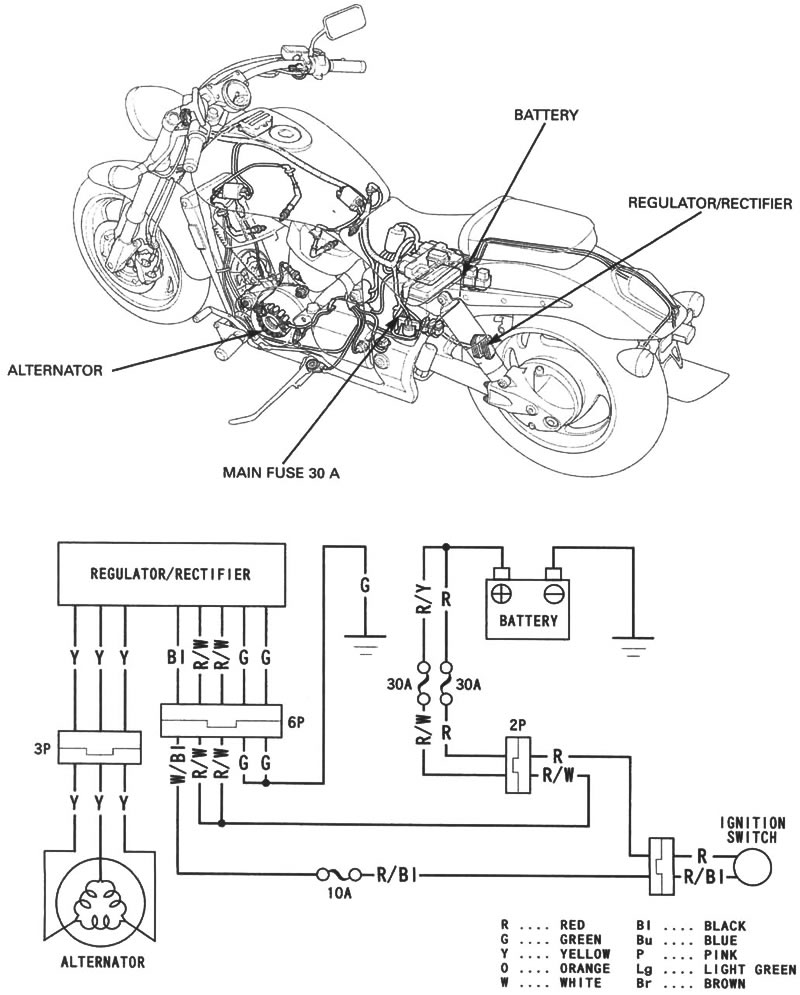
General
Caution!
- The battery gives off explosive gases; keep sparks, flames and cigarettes away. Provide adequate ventilation when charging.
- The battery contains sulfuric acid (electrolyte). Contact with skin or eyes may cause severe burns. Wear protective clothing and a face shield.
- If electrolyte gets on your skin, flush with water.
- If electrolyte gets in your eyes, flush with water for at least 15 minutes and call a physician immediately.
- Electrolyte is poisonous.
- If swallowed, drink large quantities of water or milk and call your local Poison Control Center or physician immediately, keep out of reach of children.
Always turn off the ignition switch before disconnecting any electrical component.
Some electrical components may be damaged if terminals or connectors are connected or disconnected while the ignition switch is turned to "ON" and current is present.
For extended storage, remove the battery, give it a full charge, and store it in a cool, dry place.
For a battery remaining in a shorted vehicle, disconnect the negative battery cable from the battery.
The battery caps should not be removed. Attempting to remove the sealing caps from the cells may damage the battery.
The maintenance free battery must be replaced when it reaches the end of its service life.
The battery can be damaged if overcharged or undercharged, or if left to discharge for long period. These same conditions contribute to shortening the "life span" of the battery. Even under normal use, the performance of the battery deteriorates after 2-3 years.
Battery voltage may recover after battery charging, but under heavy load, the battery voltage will drop quickly and eventually die out. For this reason, the charging system is often suspected as the problem. Battery overcharge often results from problems in the battery itself, which may appear to be an overcharging symptom. If one of the battery cells is shorted and battery voltage does not increase, the regulator/rectifier supplies excess voltage to the battery. Under these conditions, the electrolyte level goes down quickly.
Before troubleshooting the charging system, check for proper use and maintenance of the battery. Check if the battery is frequently under heavy load, such as having the headlight and taillight on for long periods of time without riding the vehicle.
The battery self-discharge when the vehicle is not in use, for this reason, charge the battery every 2 weeks to prevent sulfation from occurring.
Filling a new battery with electrolyte will produce some voltage, but in order to achieve its maximum performance, always charge the battery. Also, the battery life is lengthened when it is initially charged.
When checking the charging system, always follow the steps in the troubleshooting flow chart (page 16-3).
Battery charging
This model comes with a maintenance free (MF) battery. Remember the following about MF batteries.
- Use only the electrolyte that comes with the battery
- Use all of the electrolyte
- Seal the battery properly
- Never open the seals again
For battery charging, do not exceed the charging current and time specified on the battery. Using excessive current or extending the charging time may damage the battery.
Battery testing
Refer to the battery tester's Operation Manual for the recommended battery testing procedure. The recommended battery tester puts a "load" on the battery so the actual battery condition of the load can be measured. Recommended battery tester: BM-210-AH or BM-210 (U.S.A, only).
Specification
| ITEM | SPECIFICATIONS | ||
| Battery | Capacity | 12V - 18 Ah | |
| Current leakage | 0.1 mA max. | ||
| Voltage (20 C/68T) | Fully charged | 13.0-13.2 V | |
| Needs charging | Below 12.3 V | ||
| Charging current | Normal | 1.8 A/5-10h | |
| Quick | 9.0 A/1.0 h | ||
| Alternator | Capacity | 0.4 kW/5,000 rpm | |
| Charging coil resistance (20°C/68°F) | 0.1 - 1.0 Ω | ||
Torque values
| Crankshaft hole cap | 18 N·m (1.8 kgf·m, 13 lbf·ft) | Apply grease to the threads. |
| Change pedal pinch bolt | 12 N·m (1.2 kgf·m, 9 lbf·ft) | |
| Side stand bracket bolt | 39 N·m (4.0 kgf·m, 29 lbf·ft) | |
| Step holder bolt | 39 N·m (4.0 kgf·m, 29 lbf·ft) |
